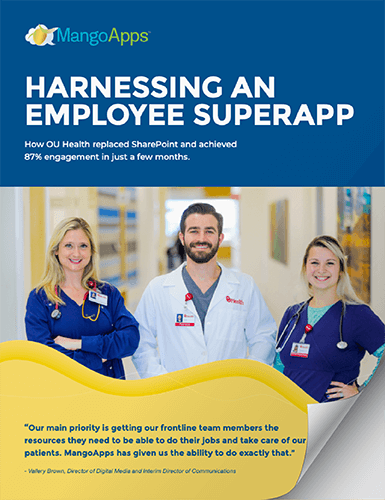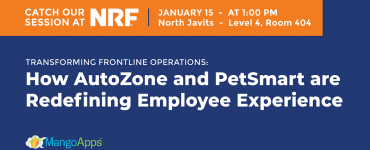This is Part 4 in our series about the differences between an intranet and employee app.
Previously, we broke down the nuances distinguishing an intranet vs. employee app and the various characteristics that makes them unique from each other. Continuing on that theme, in this installment of our series we’re here to offer a fresh perspective using simple, everyday analogies.
We might ask you to compare a city’s official website to a mobile app for residents, or a library to a personal eReader. We will take aspects of our daily lives and compare them to that of an modern intranet or employee app. These comparisons can shed light on the distinct roles intranets and employee apps play in a corporate setting.
Without further adieu we can delve right in and explore these analogies further. By the end, we should have a solid grasp of what each platform can offer.
City Website (Intranet) vs. City-Specific Mobile App (Employee App):
To kick off our exploration of intranets vs. employee apps, let’s start with something many of us interact with regularly. A city’s official website compared to a city-specific mobile app. Both are platforms designed to facilitate our daily lives, yet they serve distinctly different purposes.
City Website:
On a city’s official website we find a wealth of information that caters to a wide array of needs. Like an intranet, it’s a centralized place where you can find a rich depth of content. From historical archives and city policies, to community events and governmental updates. This resource is created to house everything a resident, or a potential visitor, might need to understand and navigate the city.
City-Specific App:
Conversely, if we think of a city-specific mobile app the focus sharpens to deliver real-time updates that aid individuals. Like an employee app, here the goal is to streamline essential information delivery. Like offering alerts on traffic conditions, upcoming events, or bills that are due for payment. It’s about bringing the most immediate and relevant information straight to the individual’s pocket. It’s not just about information; it’s about utility, ease, and personalization. It’s about honing in on what someone needs at the moment, without the additional clutter. The design and functionalities of an employee app are tailored to suit a fast-paced lifestyle. This ensures users can quickly access the tools and information they need while on the move.
Library (Intranet) vs. eReader (Employee App):
Next up in our exploration of intranet vs. employee app are two concepts that almost everyone is familiar with. A physical library with rows and rows of books. And a personal eReader, like a Kindle or Nook, that houses thousands of digital books. These two items help illustrate the diverging functionalities and purposes of intranets and employee apps respectively.
Library:
When you think of a modern intranet, envision a vast physical library with row upon row of books. It operates as a large storage space that safely stores resources, documents, and information beneficial to everyone in the organization. The library is open to all to explore various books, studies, and documents. Similarly, the intranet is a central hub where employees can find extensive data, reference materials, and corporate communications. It’s designed to encourage exploration and a deeper understanding by offering a rich reserve of resources to delve into. This helps to facilitate a comprehensive grasp of organizational knowledge.
eReader:
On the flip side, an employee app parallels the functionalities of a personal eReader, like a Kindle or Nook. While a library is static and hosts a vast array of books and resources. An eReader, in contrast, is portable and offers quick access to a curated collection of favored readings in digital format. Similar to this, an employee app is designed to streamline the individual user’s experience. It does this by offering quick access to personalized content, relevant notifications, and favored tools and resources, to facilitate an efficient work day. The employee app simplifies the user’s experience by compartmentalizing and offering the most pertinent information at the user’s fingertips. Just like how an eReader houses a personalized library for swift, on-the-go access.

Town Square (Intranet) vs. Personal Assistant (Employee App):
Moving forward, let’s focus on a more communal space versus a one-on-one aid. In this we will draw parallels between a town square and a personal assistant, which provides a simple illustration of an intranet vs. employee app experience.
Town Square:
Picture an intranet as a bustling town square. A central point where community members congregate to share news, discuss various topics, and make use of shared resources. This platform fosters a sense of community and collaboration within an organization. It’s a space where employees can engage in discussions, share updates, and access communal resources. Just like how a town square is the heart of a community, an intranet stands as a central hub. As a result this encourages openness and connectivity, fostering a collaborative atmosphere where ideas can be exchanged freely.
Personal Assistant:
Now instead, think of the employee app as a personal assistant, always there to help you manage your day efficiently. This app is your go-to for quick access to the tools you need, wherever you are. It can remind you of upcoming tasks, helping you to stay on top of your schedule. Just like a personal assistant who understands your preferences and daily routines, the employee app tailors its functionalities to suit your individual needs. This facilitates a smoother, more personalized workflow, ensuring you have what you need to succeed at your fingertips. It’s all about making the individual’s work life simpler and more efficient.
Department Store (Intranet) vs. Brand-Specific Mobile App (Employee App):
When trying to grasp the functional differences between an intranet and an employee app – it might be helpful to think of them in terms of a shopping experience. In this analogy, the intranet resembles a bustling department store. A place with a wide array of sections each offering a variety of items to meet different needs.
Department Store:
Comparing an intranet to a full-fledged department store paints a vivid picture of the wide-ranging capabilities and resources it offers. Much like a department store, the intranet is a hub that caters to various needs. It offers an extensive assortment of information and tools in a structured manner. Picture walking through a large store, with different sections dedicated to various categories. The store offers a broad spectrum of options to explore and discover. Before you is a vast space structured to facilitate a comprehensive view of everything that is available. From areas designated for different topics, and directories to guide you to the right place, this fosters an environment where employees can find everything they need in one place.
Brand-Specific Mobile App:
Now instead, think of an employee app as a specific brand’s mobile app, offering a tailored shopping experience. Just as a brand-specific app focuses on giving a personalized experience, an employee app provides a personalized work environment. It channels the essentials and streamlines the daily workflow with notifications, updates, and quick access to the tools most relevant to an individual’s role. This bespoke approach ensures that employees have a focused and individualized platform. Here they can manage their tasks efficiently with a user interface that speaks directly to them, much like a personalized shopping guide at their fingertips.
Cable Television (Intranet) vs. Streaming Services (Employee App):
To further illustrate the distinction between intranets and employee apps – consider the differences between traditional cable television and modern streaming services. This analogy can offer a clear perspective on how each platform serves its users differently.
Cable Television:
Intranet, akin to a cable television service, presents a structured lineup of channels or sections. Each harbors a scheduled array of programs or content tailored for a broad audience. It is indeed a source that hosts a vast collection of data, consequently, everyone can find something relevant to their interest. However, it generally follows a fixed schedule or structure. Meanwhile, users can have access to a wide variety of information, although not specifically catered to individual preferences.
Streaming Services:
Contrastingly, an employee app operates more like a personalized streaming service. It’s designed to uadapt to individual user preferences and offer suggestions and content that align with personal tastes and needs. Moreover, it offers the convenience of accessing content on-the-go. This lets users engage with content wherever they are. In the case of an employee app, this personalized approach ensures that employees receive updates and information that are most pertinent to them, promoting efficiency and engagement in their roles.
Newspaper (Intranet) vs. News Alert App (Employee App):
In this section, we liken the attributes of intranets and employee apps to the characteristics of newspapers and news alert apps. This comparison sheds light on the depth and immediacy each platform brings in conveying information to its users.
Newspaper:
An intranet can be compared to a traditional newspaper. The intranet provides a thorough overview of a variety of topics through distinct sections and detailed articles. This is similar to how a newspaper centrally lays out a diverse array of news pieces, encompassing local events, global happenings, and more. It delivers a comprehensive package of information, where users can explore different topics and gather detailed insights. All-in-all this can foster a deeper understanding and connection to the subjects at hand.
News Alert App:
On the other hand, an employee app functions similarly to a news alert app. This experience is crafted to deliver immediate notifications about the most current and pertinent news based on a user’s preferences. Similarly, the employee app narrows down the information to what is most relevant to the individual. This ensures they are promptly informed about the vital updates without having to sift through a sea of information. This focused approach helps to maintain a steady stream of the most crucial updates to keep employees engaged and informed.
Train Station (Intranet) vs. Ride-Hailing App (Employee App):
In this segment, we draw parallels between intranets and employee apps to train stations and ride-hailing apps respectively. This analogy illustrates the different levels of customization and accessibility provided by each platform.
Train Station:
An intranet mirrors the functionality of a train station. The station serves as a centralized hub where everyone can find different “trains,” or resources. It directs them to various “destinations,” or information points. Just like a train station, the intranet stands as a comprehensive platform offering a plethora of resources and data streams accessible to everyone in the organization. It is a space that encourages exploration and fosters a community vibe. This gives everyone the liberty to access a rich repository of information to aid them in their roles.
Ride-Hailing App:
Conversely, an employee app resembles a ride-hailing app, characterized by its personalized, immediate, and direct service. Much like personalization of a ride-hailing app, the employee app facilitates a tailored experience, presenting tools and features that address the immediate needs and preferences of the individual user. This means the employee can quickly access the exact tools or pieces of information they need at that moment. Thereby helping them to stay focused to efficiently carry out their tasks without unnecessary distractions.
In conclusion, the journey we embarked upon exploring various analogies has equipped us with a deeper understanding of the nuanced differences and unique characteristics distinguishing intranets and employee apps. By drawing inventive parallels to familiar experiences, we we can see clearly how each platform serves different purposes and suits distinct needs.
Conversely, while the intranet emerges as a comprehensive hub fostering community, exploration, and a rich reservoir of resources, the employee app distinctly stands out for its personalized, user-centric approach, which readily facilitates immediate access to relevant tools and information. Moreover, this focused discussion aids stakeholders in recognizing the distinctive strengths of each platform, thereby helping businesses make informed decisions when it comes to implementing the tools that will most optimally serve their teams. Ultimately, through understanding the divergent functionalities and benefits of both intranets and employee apps, organizations can adeptly leverage these platforms to craft environments that are both collaborative and individually tailored, thereby paving the way for a workspace that is harmonious and operates with heightened efficiency.
Schedule a Demo!
Get the best of both worlds with MangoApps Employee SuperApp! Not ready for that transformation? Start with either a MangoApps Modern Intranet or MangoApps Employee App and we’ll help you transform to a SuperApp when you are ready.








